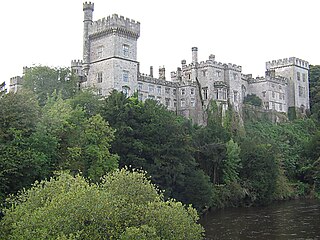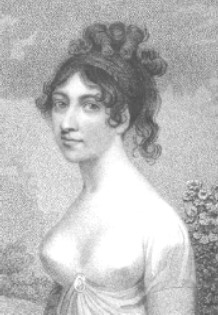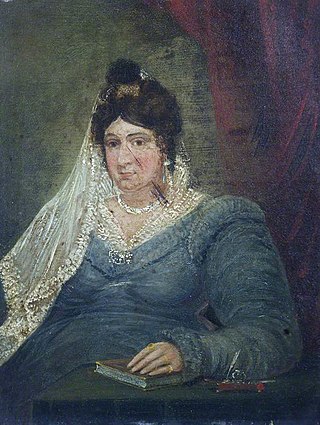
Gothic fiction, sometimes called Gothic horror in the 20th century, is a loose literary aesthetic of fear and haunting. The name is a reference to Gothic architecture of the European Middle Ages, which was characteristic of the settings of early Gothic novels.

Ann Radcliffe was an English novelist and a pioneer of Gothic fiction. Her technique of explaining apparently supernatural elements in her novels has been credited with gaining respectability for Gothic fiction in the 1790s. Radcliffe was the most popular writer of her day and almost universally admired; contemporary critics called her the mighty enchantress and the Shakespeare of romance-writers, and her popularity continued through the 19th century. Interest has revived in the early 21st century, with the publication of three biographies.

Lismore Castle is a castle located in the town of Lismore, County Waterford in the Republic of Ireland. It belonged to the Earls of Desmond, and subsequently to the Cavendish family from 1753. It is currently the Irish home of the Duke of Devonshire. It was largely re-built in the Gothic style during the mid-nineteenth century for The 6th Duke of Devonshire.

The Monk: A Romance is a Gothic novel by Matthew Gregory Lewis, published in 1796. A quickly written book from early in Lewis's career, it was published before he turned twenty. It is a prime example of the male Gothic that specialises in the aspect of horror. Its convoluted and scandalous plot has made it one of the most important Gothic novels of its time, often imitated and adapted for the stage and the screen.

Charlotte Dacre, born Charlotte King, was an English author of Gothic novels. Most references today are given as Charlotte Dacre, but she first wrote under the pseudonym "Rosa Matilda" and later adopted a second pseudonym to confuse her critics. She became Charlotte Byrne on her marriage to Nicholas Byrne in 1815.

Matthew Gregory Lewis was an English novelist and dramatist, whose writings are often classified as "Gothic horror". He was frequently referred to as "Monk" Lewis, because of the success of his 1796 Gothic novel The Monk. He also worked as a diplomat, politician and an estate owner in Jamaica.

The St. Thomas Church is a Lutheran church in Leipzig, Germany, located at the western part of the inner city ring road in Leipzig`s district Mitte. It is associated with several well-known composers such as Richard Wagner and Felix Mendelssohn Bartholdy, and especially Johann Sebastian Bach, who worked here as a Kapellmeister from 1723 until his death in 1750. Today, the church also holds his remains. Martin Luther preached here in 1539.

Ann Julia Hatton, was a popular novelist in Britain in the early 19th century and author of Tammany, the first known libretto by a woman.

Swedish Romantic literature denotes Swedish literature between 1809 and 1830. In Europe, the period from circa 1805–1840 is known as Romanticism. It was also strongly featured in Sweden, based on German influences. During this relatively short period, there were so many great Swedish poets, that the era is referred to as the Golden Age of Swedish poetry. The period started around 1810 when several periodicals were published that contested the literature of the 18th century. An important society was the Gothic Society (1811), and their periodical Iduna, a romanticised retrospect to Gothicismus.

Tristram Risdon was an English antiquarian and topographer, and the author of Survey of the County of Devon. He was able to devote most of his life to writing this work. After he completed it in about 1632 it circulated around interested people in several manuscript copies for almost 80 years before it was first published by Edmund Curll in a very inferior form. A full version was not published until 1811. Risdon also collected information about genealogy and heraldry in a note-book; this was edited and published in 1897.
Eliza Parsons was an English Gothic novelist, best known for The Castle of Wolfenbach (1793) and The Mysterious Warning (1796). These are two of the seven Gothic titles recommended as reading by a character in Jane Austen's novel Northanger Abbey.

St. Irvyne; or, The Rosicrucian: A Romance is a Gothic horror novel written by Percy Bysshe Shelley in 1810 and published by John Joseph Stockdale in December of that year, dated 1811, in London anonymously as "by a Gentleman of the University of Oxford" while the author was an undergraduate. The main character is Wolfstein, a solitary wanderer, who encounters Ginotti, an alchemist of the Rosicrucian or Rose Cross Order who seeks to impart the secret of immortality. The book was reprinted in 1822 by Stockdale and in 1840 in The Romancist and the Novelist's Library: The Best Works of the Best Authors, Vol. III, edited by William Hazlitt. The novella was a follow-up to Shelley's first prose work, Zastrozzi, published earlier in 1810. St. Irvyne was republished in 1986 by Oxford University Press as part of the World's Classics series along with Zastrozzi and in 2002 by Broadview Press.

Louisa Pitt (1754/56–1791) was the second daughter of the British diplomat and politician George Pitt, 1st Baron Rivers (1721–1803), and his wife, Penelope Atkins.

Emma Parker was an Anglo-Welsh novelist of whom very little is known, although her work was generally well-reviewed during her lifetime. Her epistolary novel Self-Deception explores the cultural and religious differences between the English and the French.
Eleanor Sleath was an English novelist, best known for her 1798 gothic novel, The Orphan of the Rhine, which was listed as one of the seven "horrid novels" by Jane Austen in her novel Northanger Abbey.

Wolfstein; or, The Mysterious Bandit is an 1822 chapbook based on Percy Bysshe Shelley’s 1811 Gothic horror novel St. Irvyne; or, The Rosicrucian.

Wolfstein, The Murderer; or, The Secrets of a Robber’s Cave is an 1850 chapbook based on Percy Bysshe Shelley’s 1811 Gothic horror novel St. Irvyne; or, The Rosicrucian.
Sarah Scudgell Wilkinson was an English writer of children's books and novels. Some of her many chapbooks adapted existing novels.

Amelia Beauclerc was a British Gothic novelist.















